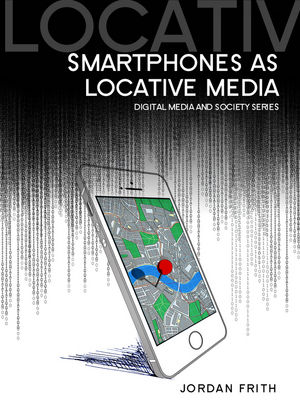How do location-based services impact social life and reconfigure interpretations of physical spaces? In Smartphones as Locative Media, the author maintains that physical spaces are differentially experienced by people if digital information is accessed through locative media, such as the smartphone, writes Vyacheslav Polonski. This information acts not only as an exterior informational layer that augments the space, but also as a technology that mediates mobility, altering their environmental awareness and sense of place.
 Smartphones as Locative Media. Jordan Frith. Wiley. 2015.
Smartphones as Locative Media. Jordan Frith. Wiley. 2015.
Thinking about the societal implications of the Internet, it is difficult not to notice how location-based mobile technologies have begun to shape how we access, navigate and experience physical places. Navigating cities with Google Maps, redeeming location-based offers from Groupon, and checking-in to impressive landmarks on Facebook: these are but a few examples of the increasingly ubiquitous role of locative media in everyday life. The recently published book Smartphones as Locative Media provides a detailed account of some of these emerging practices and calls for a re-evaluation of the complicated relationship between the Internet and physical space.
The author of the book, Dr Jordan Frith from the University of North Texas, draws on his substantial empirical work on the location-based social network site Foursquare, as well as years of research in computer-mediated communication. The book also benefits from the author’s collaborations with other notable academics in the field of locative media such as Jason Farman, Christian Licoppe, Richard Ling and Rowan Wilken, to name a few.
The main argument of this book is that locative media does not only impact what types of location-based information we can access, but also how this new form of media is reconfiguring our perceptions of, and interactions with, location. Even though this argument – that online data shapes offline experiences – is not entirely new, the book succeeds at providing the much needed context in contemporary debates about the role of smartphones in everyday life. Frith’s theoretical framework relies heavily on the concept of “hybrid space”, introduced by communication scholar Adriana de Souza e Silva, which asserts that people’s interpretation of physical spaces are formed through a combination of social interaction, digital information and the properties of the physical space itself. In particular, Frith maintains that physical spaces are differentially experienced by people if digital information is accessed through locative media, such as the smartphone. This information acts not only as an exterior informational layer that augments the space, but also as a technology that mediates mobility, altering their environmental awareness and sense of place.

What I found most appealing about this book is its multidisciplinary approach that spans across different schools of thought, providing readers with a contextual understanding of the main scholarly debates on how location-based services impact social life. In fact, the very structure of the book facilitates such a multidisciplinary understanding, focusing on particular aspects of locative media in each chapter. It begins with a general conceptual exposition of the notions of “space” and “place” in chapters 1 and 2 and moves further into concepts of mobility and identity pertaining to locative media. Next, the author explains the technological infrastructure of GPS location tracking in chapter 3 and reflects on the differences between Apple and Google in terms of their platform strategies.
Chapter 4 clearly constitutes the strongest chapter of this book, where Frith reviews key theoretical perspectives, empirical findings and ongoing debates about how mobile mapping impacts how people navigate space and coordinate behaviours. Drawing from postcognitive theories of technology, Frith posits that mobile mapping applications can be seen as part of a transactive memory network that enables users to offload the cognitive task of wayfinding to their smartphones. For example, users of Google Maps do not need to form as detailed cognitive maps of their surroundings because they know where to find mapping information. This is an interesting argument that has been supported by empirical evidence from the literature and neatly integrates into the general theme of this book.
In the fifth and perhaps weakest chapter of the book, Frith produces an argument about the evolution of spatial identity and location-sharing practices on social network sites, such as Foursquare, Latitude and Dodgeball. The author reviews the growing literature on the motivations of users to share their location on social network sites as a new way to communicate and coordinate with friends, as well as a performative act of their identity to others. However, Frith does not provide readers with sufficient research-based information to distinguish performances from exhibitions of identity on location-based social network sites. More to the point, the author gives extremely short shrift to the numerous theories of identity and self-presentation in the context of social media. The book would have benefited from a more extensive review of these theories to better understand how people are using offline locations to construct online identities. It must be emphasised, however, that the author’s focus of attention in this chapter has been on providing a wide-ranging overview of these dynamics. As such, this chapter still serves as a helpful starting point for readers who are undertaking early investigations of the role of identity in locative media.
In the following chapters Frith takes readers on a guided tour across a range of important topics related to locative media, discussing the archiving function of personal memories through location-based applications, the market forces affecting locative media and users’ negotiations of locational privacy. Each chapter has an individual introduction that relates locative media to the author’s personal life, but still does not suffer from unwanted subjectivity. Indeed, these personal examples are refreshing and make for the most compelling reading. The book concludes with an outlook on a possible future for locative media.
Perhaps the book’s greatest strength is its focus on user practices, rather than the design of specific mobile applications. The implication, therefore, is that the book is able to elucidate some of the theoretical underpinnings of locative media regardless of the changing nature of its underlying technology. In other words, even if Foursquare changes the design of its application, modifies its core features or ceases to exist altogether, only to be replaced by a new location-based social network site, there are still important lessons to be learned about how location information conditions people’s experiences of place that are put forth in this book. This is a substantial argument against technological determinism, which is unfortunately still absent from similar contemporary books on emerging media.
In summary, Frith’s book provides a useful road map for readers seeking to obtain an in-depth understanding of the relevance and impacts of locative media on society. The book is well-structured, innovative in its thinking, and contains a number of original case studies and rich theoretical discussions that will be equally interesting for experienced academic audiences and the general public. It succeeds at getting readers engaged and curious about how smartphones as locative media are affecting our lives and experiences. Overall, I appreciated the author’s tone and insight, and highly recommend this book.
Vyacheslav W. Polonski (@slavacm) is a PhD candidate at the Oxford Internet Institute and a Global Shaper at the World Economic Forum. He received his MSc degree with distinction from the University of Oxford and his BSc degree with distinction from the London School of Economics and Political Science. In 2013, he was a TEDx speaker at IE University in Spain. Vyacheslav’s current research focuses on network science and the sociology of the Internet, exploring network effects and the collective dynamics of social media adoption.







